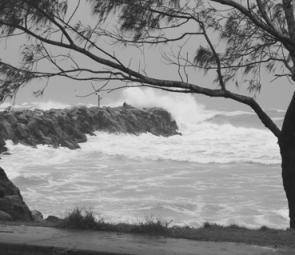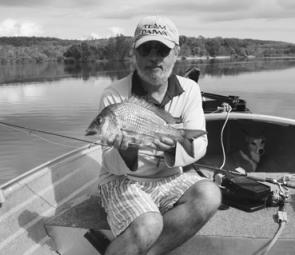I like fishing in May. The mornings are crisp enough to remind you you’re alive yet sufficiently mild to prevent death by exposure. The northering sun during the middle of the day won’t turn you into a mass of sweat and sunburn and, most importantly, you can catch just about anything.
I like the run of tailor that happens in May at first and last light around the rocky washes and beach gutters. In the increasing westerly regimes of Winter they usually hug the coast, molesting the gathering bait schools and moving within easy casting distance of a metal lure, popper or ganged pilchard or garfish.
There have been some excellent greenbacks around for some months with plenty of fish nudging 3kg, although the smaller choppers should be gathering momentum in May. The heavy swells of past months often kept the tailor out of casting distance but there should be more opportunities now at places like Flat Rock and Skennars and Lennox headlands, Cape Byron and Seagull Rocks at Brunswick Heads.
The bait schools with attendant tailor and small tuna should also help improve what has been a dismal mackerel season around Evans Head and Ballina. Lousy weather and floodwaters have stymied most mackerel efforts but as long as the water keeps above 23° we’re in with a chance of a season yet. Spotties have been rare, while the Spanish could still hit their straps at such places as South Evans and Riordans reefs, the pinnacle off Lennox Head and the reefs off New Brighton north of Brunswick Heads.
Even if the macks don’t show there should be enough snapper around to make an offshore trip rewarding. Seemingly endless rain and big seas have made the inshore reefs attractive to the reds, thanks to an influx of plenty of feed dislodged from the ocean rocks and disgorged from the swollen rivers. You can also add cobia, jewfish, teraglin, tailor, longtail tuna and kingfish to the inshore reef fare so there are plenty of reasons to fuel up and head out.
The beaches should also fish very well this month as the spawning migrations of baitfish, mullet, bream, tailor and blackfish escalate. The westerly winds should keep the surf small to allow easy travelling and feeding for these species but it’s also a prime month for the pro netters to ply their trade so calm weather is a two-edged sword.
4WD fishos had an unexpected win when the Department of Lands and Environment decided to rethink the proposed severe restrictions on beach driving between South Ballina and Evans Head. Green extremists had plotted virtual closure of around 30km of sand under the guise of protecting small populations of pied oystercatchers but at times agitated protest meetings and some serious lobbying mean there will likely be a fairly open permit system along with increased control of predatory foxes and signposted nesting areas.
Bream should be in good numbers day and night with tailor at dawn and dusk with bigger greenbacks and jewfish plying their trade in the dark. Look for deeper washy gutters and holes, especially at high tide.
After a quite disastrous Autumn the Richmond, Brunswick and Evans rivers should provide some good fishing in their lower reaches. Flooding and endless freshes kept the rivers chocolate for months on end with only a few hundred metres of fishable water.
The Ballina jewie brigade took good advantage of the conditions to nail some impressive numbers of fish to around 25kg and for the first time those casting soft plastic shads and minnows seemed to be more prevalent than the large crankbaits, feathers and live mullet of seasons past.
Flathead and whiting were the first to dare re-enter the river with some good flattie catches along the Porpoise Wall and at the time of writing whiting had hit their straps upstream as far as Pimlico. We can expect the whiting to taper off well and truly this month but the bream should be the big movers in the lower estuaries.
March marked the fifth anniversary of the massive fish kills and six-month fishing closure following the 2001 flood and local river custodian and third-generation pro river netter John Gallagher had the nous to call a meeting of interested parties to see how far we had come in preventing a recurrence. Sadly, not far seems to be the answer.
Despite great advances to improve water quality after flooding over the past decade in the Tweed and Clarence catchments, it seems the Richmond is dragging the chain. That’s indicated further by widespread but smaller fish kills following recent flooding.
Local flood mitigation authorities and some scientists say further mass kills are inevitable due to the huge potential of large areas of the catchment to produce and harbour oxygen-destroying ‘black water’. One litre of black water can strip all the oxygen from as much as 30 litres of river water.
While much naturally occurring black water might be unavoidable during floods, it doesn’t mean that better management of drains and floodgates won’t reduce the volumes that join the main river during floods and in better times and we have to start somewhere. When asked who controlled floodplain management, a spokesman for the local flood mitigation council was able to say only, “That’s not immediately clear.”
The group resolved to meet again this month to try to thrash out some positive solutions.
Reads: 2785
Big seas have made fishing the seawalls a very hazardous experience but it’s conditions like this that bring on the jewfish.

Bream should hit their straps in the estuaries and along the beaches and rocks this month.




